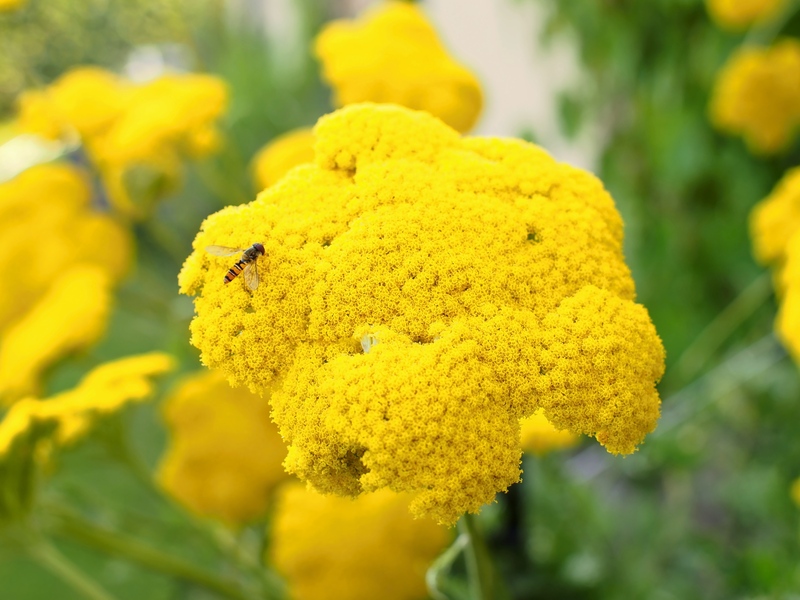Nature's Ally: How Gardening Fights Climate Change
Posted on 30/06/2025
Nature's Ally: How Gardening Fights Climate Change
In the face of ever-increasing global temperatures and unsettling environmental news, individuals often wonder what they can do to make a difference. The answer, surprisingly, may lie right in your own backyard. Gardening--often seen as a relaxing pastime--has emerged as a potent weapon in the battle against climate change. In this comprehensive article, we'll uncover how gardening helps fight climate change, the science behind its benefits, and actionable steps you can take to become nature's ally.
The Climate Crisis and Our Role
Climate change, driven mainly by excessive greenhouse gas emissions, is the defining environmental challenge of our era. Melting glaciers, extreme weather events, and declining biodiversity are stark reminders of its reality. While large-scale policy changes and renewable energy initiatives are crucial, the cumulative power of individual actions--from reducing waste to growing plants--can help tip the scales in our planet's favor.

How Does Gardening Combat Climate Change?
Gardening may seem humble, but it packs a mighty punch in addressing the root causes of climate disruption. Here are the key ways gardening fights climate change:
- Carbon Sequestration
- Reducing Urban Heat
- Enhancing Biodiversity
- Lowering Food Miles
- Minimizing Resource Consumption
1. Carbon Sequestration: Capturing Carbon, Growing Solutions
Plants are natural carbon dioxide vacuums. Through photosynthesis, they absorb atmospheric CO2, a significant greenhouse gas, and convert it into oxygen and organic matter. When you plant trees, shrubs, and flowers, you're essentially helping lock away carbon in their trunks, stems, leaves, and roots, as well as in the soil.
- Soil Health: Healthy garden soil can store more carbon than degraded soils. Techniques like composting and mulching support soil microorganisms that play a key part in this process.
- Trees and Perennials: The deeper the roots and the larger the plant mass, the more carbon can be sequestered over time. Fruit trees, hardy shrubs, and perennial flowers are especially effective.
2. Reducing the Urban Heat Island Effect
Urban areas notoriously trap heat due to roads, buildings, and sparse greenery. This phenomenon, known as the urban heat island effect, not only affects health but also escalates energy usage for cooling--contributing further greenhouse gases. Gardens offer a natural remedy.
- Cooling Effect: Plants cool the air through shade and evapotranspiration, lowering local temperatures.
- Green Roofs and Walls: Plant-covered roofs and vertical gardens provide insulation, reduce heat absorption, and improve overall climate resilience in cities.
3. Enhancing Biodiversity: The Web of Life
Climate change and habitat loss go hand-in-hand, leading to declining populations of many species. Gardening to support pollinators and native wildlife is critical.
- Pollinator Pathways: Planting diverse, native flowering plants supports bees, butterflies, and hummingbirds, which are crucial for healthy ecosystems and food production.
- Habitat Creation: Even small gardens provide refuge and food for insects, birds, and small mammals.
4. Lowering Food Miles: Grow Local, Eat Local, Save Carbon
One of the most effective ways gardening fights the climate crisis is by reducing food miles--the distance food travels from farm to plate, often spanning thousands of kilometers.
- Fresh From the Garden: Homegrown vegetables, fruits, and herbs mean you avoid the emissions associated with large-scale agriculture, storage, transportation, and packaging.
- Seasonal, Organic Choices: By growing your own produce, you control what goes into your food and when you harvest, minimizing waste and fossil fuel use.
5. Minimizing Resource Consumption and Waste
A sustainable garden relies on efficient use of resources, reducing demand for harmful chemicals and wasteful practices.
- Rainwater Harvesting: Collecting and using rainwater for irrigation eases pressure on local water systems.
- Composting: Returning kitchen and yard scraps to the soil as compost boosts nutrient levels naturally, eliminating the need for synthetic fertilizers.
Types of Gardens That Help Stop Climate Change
Not all gardening is created equal when it comes to fighting climate change. Here are some climate-friendly gardening approaches:
- Edible Gardens: Vegetable plots, herb gardens, and small orchards reduce reliance on store-bought produce and foster a deeper connection to food sources.
- Native Plant Gardens: Plants indigenous to your region require less water and fewer inputs, and provide the best support for local wildlife.
- Permaculture Gardens: Inspired by natural ecosystems, these gardens integrate plants, animals, and people to create self-sustaining environments with minimal waste.
- Pollinator Gardens: Designed to attract and nourish bees, butterflies, and other beneficial insects.
- Rain Gardens: Landscaped areas designed to absorb stormwater runoff and filter pollutants, aiding in groundwater recharge.
Best Practices: Creating a Climate-Positive Garden
Ready to become a climate defender in your own backyard? Here are expert tips for transforming your green space into a tool to fight global warming:
Prioritize Native and Drought-Tolerant Plants
Choose native species that are adapted to your region's weather and pests, requiring less water and fewer chemicals. Select drought-tolerant varieties in areas with water shortages.
Use Organic Methods
Opt for natural fertilizers and integrated pest management rather than synthetic chemicals. Composting kitchen and yard waste both reduces landfill methane emissions and enriches soils.
Maximize Plant Coverage
A garden filled with ground covers, shrubs, and diverse perennials is better at sequestering carbon and preventing soil erosion. Avoid bare soil where possible.
Create Wildlife Habitat
Install birdhouses, water sources, and insect hotels to foster biodiversity. A variety of plants with staggered flowering times will support wildlife throughout the year.
Reduce Lawn Area
Traditional grass lawns consume lots of water, fertilizer, and chemical treatments. Replace some (or all) of your lawn with wildflowers, clover, edible beds, or native groundcovers.
Conserve Water
Use mulch to retain moisture, install drip irrigation, and collect rainwater in barrels. Water your garden early in the morning to minimize evaporation.
Support Urban Greening Initiatives
Join local tree-planting programs, participate in community gardens, or advocate for green public spaces in your city. Every bit of greenery matters.
Beyond the Backyard: The Social Benefits of Climate-Friendly Gardening
Gardening for the climate does more than just sequester carbon--it also strengthens communities and promotes wellbeing.
- Community Bonding: Shared gardens foster connections between neighbors and diverse groups.
- Education: School and public gardens provide a living laboratory for teaching about ecology, nutrition, and climate change.
- Mental Health: Numerous studies show that time spent among plants reduces stress and promotes happiness--a true nature's ally for human health.
The Science: Studies Proving Gardening's Impact on Climate Change
Is gardening really making a difference? The answer is a resounding yes. Research published in journals like Nature, Science, and Environmental Research Letters reveals:
- Private gardens in the UK alone store an estimated 10 million tons of carbon.
- Green roofs can reduce surrounding air temperatures by up to 5?C (9?F) in urban environments.
- Urban trees sequester more carbon per hectare than some managed forests, especially when maintained for long life and diversity.
- Food forests and permaculture plots have been shown to outperform traditional agriculture in carbon capture and ecosystem services.
Gardening for Climate Action: Getting Started
You don't need to be a professional horticulturist to make a difference. Here are simple steps to start your climate-conscious gardening journey:
- Assess Your Site: Observe soil quality, sun exposure, and microclimates.
- Plan for Diversity: Mix trees, shrubs, herbs, and vegetables with staggered planting times.
- Source Responsibly: Choose seeds and plants from local, ethical providers.
- Reduce, Reuse, Recycle: Repurpose containers, tools, or materials to minimize waste.
- Share the Bounty: Trade or gift extra produce and seeds; inspire neighbors to join your climate action movement.
Overcoming Challenges: Climate-Resilient Gardening
Climate change also brings new challenges for gardeners: unpredictable weather, droughts, invasive pests, and more. Here's how a climate-friendly garden stays resilient:
- Diverse Plantings: A mix of species buffers against disease and pest outbreaks.
- Soil Management: Building rich, organic soil increases water retention and plant health.
- Flexible Designs: Use raised beds, containers, or moveable structures to adjust to changing conditions.
- Keep Learning: Stay updated with local gardening resources, workshops, and online communities.

The Future: Scaling Up, Multiplying Nature's Impact
Individual gardens, when multiplied by millions, can create corridors of biodiversity and resilience across cities, suburbs, and rural areas. Organizations now coordinate national tree-planting drives, urban food forest projects, and large-scale community composting. Every plant put in the ground is a vote for a cooler, greener future.
Conclusion: Be Nature's Ally Against Climate Change
Fighting climate change isn't only about major technology or governmental shifts. Sometimes, it's as elemental as nurturing life in your garden. By understanding how gardening supports the fight against climate change, you become part of a global movement. Your backyard--or even a single balcony planter--plays a vital role in creating a healthier, more resilient world. Get your hands dirty, grow green, and let your garden help heal the planet.
Are you ready to join the frontlines of climate action from your own home? Start gardening--and become nature's ally today!

